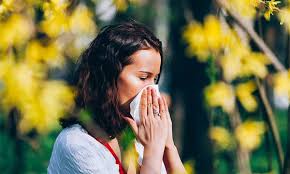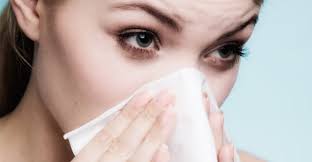Content of the Article
Your allergies If you think it's not common in the winter season, think again. Although cold weather brings relief to people with seasonal allergies, some of the allergy symptoms may persist during the colder months.
What Are Allergies?
Allergies are caused by the immune system overreacting to typically harmless substances in the environment. Common allergens include pet hair, dust mites, foods (such as peanuts or shellfish), and pollen.
Seasonal allergies (also known as hay fever) are quite common. Airborne allergens can be irritating at any time of the year and cause typical allergy symptoms such as allergic rhinitis, sneezing, and inflammation of the nasal cavity causing runny or stuffy nose.
What Are Winter Allergies?
Winter allergy symptoms are ordinary seasonal allergy symptoms. However, due to the colder and harsh weather typical of the winter season, it is more likely to spend more time indoors and increase exposure to indoor allergens.
Winter allergySome of the most common indoor allergens that can trigger are:
Dust particles in the air
Dust mites
Pet dander (protein-bearing skin flakes)
Mildew
Cockroach feces
Indoor winter allergies are very common. In industrialized areas, for example, 4 in 1 people are allergic to dust mites.
The best way to relieve allergy symptoms is to take preventive measures.
What are the Causes of Winter Allergy?
Winter allergiesare allergies that occur during the colder months. Due to the cold and harsh temperatures in the outdoor environment, people often spend time indoors and their exposure to indoor allergens increases.
According to the American Academy of Allergy, Asthma, and Immunology, the most common indoor allergens are; airborne dust particles, dust mites, indoor mildew, pet dander (protein-bearing skin flakes) and cockroach feces.
Dust mites
They thrive in a warm and humid environment and are mostly found in beds, carpets, and furniture.
Dust mites are one of the most common indoor allergens and cause year-round discomfort. Those who are allergic to dust mites are most bothered by their own homes.
You will notice the symptoms immediately when you stir the powder, usually before you broom or after dust. Molds, pollen, pet dander can also contribute to dust allergies.
You can reduce or prevent your symptoms by removing the items that cause the dust allergy. Choose wooden floors over carpets, clean your home with a HEPA filter vacuum cleaner, use leak-proof covers for your mattresses and pillows, and regularly wash your sheets in hot water.
Pet danger
Dead skin scales adhering to many surfaces in the home such as mattresses, carpets and upholstery are dangerous.
It is upsetting for pet lovers to experience allergy symptoms after being with their pets. Allergy symptoms can be constant because exposure can be anywhere - in pet-friendly workplaces, restaurants and shops, school, nursery, wherever the pet owner is present.
Avoidance is the best way to manage a pet allergy, but you don't have to be separated from your furry family members.
Keep your pet out of your bedroom, wash your hands with soap and water after playing with your pet, clean the carpets with a HEPA vacuum cleaner, and wash your pet once a week.
Indoor mildew
Humid weather outside increases mold growth in dark and humid areas under bathrooms, basements and sinks.
Molds live inside and outside your home. They thrive in humid places such as bathrooms and kitchens, and unfortunately most mold cannot be seen with the naked eye. As the spores get into the air, they can cause allergic reactions and worsening of asthma symptoms.
Wear a mask while gardening, and once inside, take a shower to remove mold spores and rinse your nose with salt water.
In the kitchen, quickly clean up any spills or leaks to prevent mold growth. Use a dehumidifier to reduce moisture in areas such as bathrooms and basements.
Clean your trash cans and refrigerator drawers. For severe mold problems, call an expert.
Cockroach feces
The cold weather outside drives the cockroaches indoors, basically causing them to begin breeding in kitchen cabinets or under the sink. Cockroaches often in urban areas winter allergiestriggers.
Cockroaches can enter your home through windows and cracks in walls or doors, looking for warm places during the cold winter months.
Like dust mites, spilled saliva, faeces, and body parts winter allergy symptomsIt can trigger. Prolonged exposure to cockroaches can even lead to sinus or ear infections.
What Are the Symptoms of Winter Allergy?
- Sneezing
Skin rash
Runny nose
Itching of the throat, ears and eyes
Trouble breathing
Dry cough
Low fever
Feeling sick
Severe winter allergiesrapid breathing, anxiety, fatigueIt can also cause symptoms such as wheezing and chest tightness.
Winter Allergy Or Cold?
Winter allergyIt occurs when the body releases histamine, which creates an inflammatory response to allergens. It can happen at any time of the year, and symptoms can last for up to several days.
On the other hand, the common cold is caused by the spread of the virus through small droplets in the air when someone carrying the virus coughs, sneezes or speaks.
Colds can happen at any time of the year, and symptoms can last from a few days to two weeks.
Diagnosing Winter Allergy
If allergic symptoms persist for more than a week, consult a doctor. The doctor will ask you about your symptoms and will perform a skin test.
The test checks for allergic reactions to different substances at once and identifies allergies caused by pollen, pet dander, dust mites or mold.
The skin test is done using a needle with a small amount of allergen extract injected into the skin on your arm. The area is then examined for signs of an allergic reaction for 15 minutes.
Treatment of Winter Allergies
Winter allergies home treatment can be. Here are some treatment methods ...
Allergy medications
Antihistamines can effectively treat allergy symptoms.
Nasal nasal cleansing
It is cleaned by giving clean water through the nostrils to remove all allergens.
Immunotherapy
If you have pet allergies, you may want to consider immunotherapy. This method tries to increase your body's immunity by exposing you to a very small amount of allergens.
Nasal sprays
Nasal sprays, such as a runny or itchy nose from winter allergy symptoms it can provide relief. It blocks the effects of histamine, a chemical released by the immune system during an allergy attack.
Prevention of Winter Allergies
Use a humidifier to reduce the humidity inside the house. The humidity level should be about 30% to 50%.
- Wash your clothes and bedspreads with hot water daily to reduce clothes and bed mites.
- Clean the floor every day.
- Keep your kitchen clean by removing any leftovers after you or your pets have finished their meals.
- Eliminate leaks in your bathroom, basement or roof to prevent moisture from getting in.
- Bathe your pet once a week to minimize pet danger.
- Remove the rug and use a rug or small blanket instead.
Seal cracks and openings in windows, doors, walls or kitchen cabinets where cockroaches can easily enter.
- Keep your kitchen and bathroom dry to prevent mold.
When to See a Doctor for Winter Allergy?
Allergies are not usually an emergency. However, they can worsen asthma symptoms. It is important to consult a healthcare professional if:
- The person's allergies become so severe that it interferes with daily life.
- If the person's cold symptoms persist even after 1-2 weeks.
- If the newborn has wheezing, difficulty breathing, or symptoms of allergies or colds.
- If the person does not know whether or not they are allergic to what they are allergic to.
As a result;
Winter allergy is essentially the same as seasonal allergies in terms of symptoms. The following symptoms are seen:
Itching
- Sneezing
Rashes
Runny or stuffy nose
Taking allergy medication, cleaning the nose and sinuses, or taking preventative measures can help reduce symptoms as you spend more time indoors in the winter.















